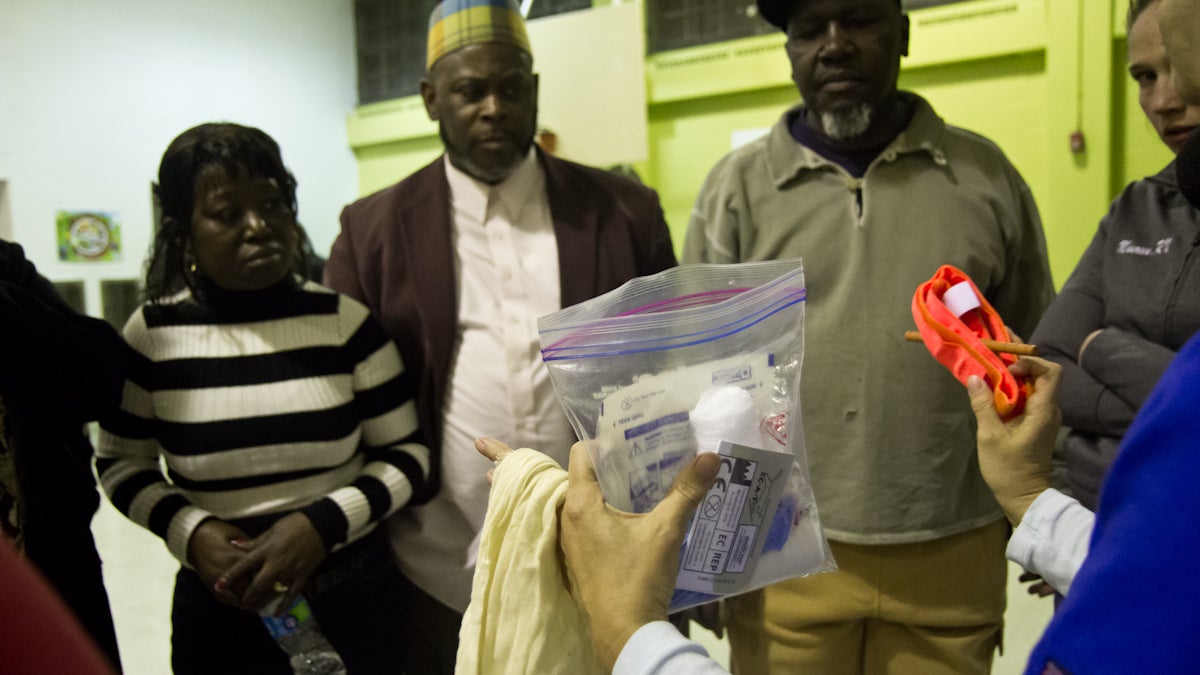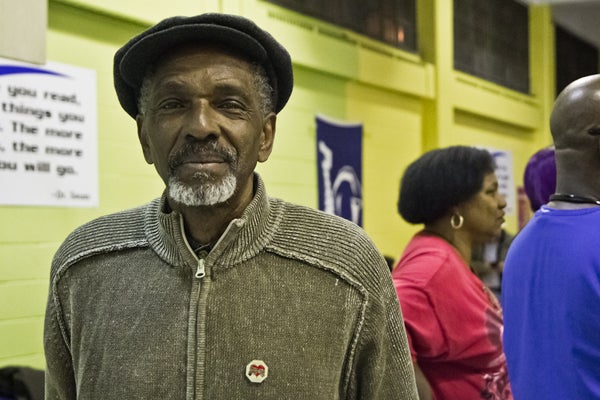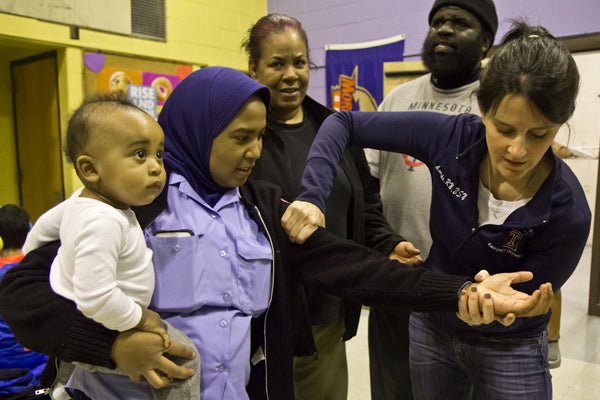In Philadelphia, bystander first aid turns everyday citizens into first responders
Listen
Fighting Chance hopes to provide communities with kits that will assist in helping victims staunch bleeding in the event of traumas. (Kimberly Paynter/WHYY)
In Philadelphia, it’s gun violence that makes first aid skills so necessary for ordinary residents.
After the Paris bombings, firefighters in a little town in northern France taught residents how to tie tourniquets.
In Oakland, California, two women, worried about the slow response of paramedics, showed their neighbors how to slow bleeding after a stabbing.
In Philadelphia, it’s gun violence that makes first aid skills so necessary for ordinary residents.
“When a young African-American aged 15 to 29 dies in Philadelphia, more than half [of] the time, it’s a gun homicide,” said Scott Charles, the trauma outreach coordinator at Temple University Hospital.
“It’s not because of cancer. It’s not because of house fires. It’s because somebody pointed a gun at him and pulled that trigger,” Charles said.
This sparked one North Philadelphia activist, Wayne Jacobs, to suggest the idea of teaching community members first aid skills in order to save more lives.
For a decade, community health workers based at Temple have tried to prevent gun injury in North Philadelphia. Charles is waiting for laws to change and the political debate to untangle, but he says bystander first aid is something that can help right now.
“We have to put the power in people’s hands to address this issue,” he said.
 Wayne Jacobs is the executive director of X-Offenders and had the idea for Fighting Chance. (Kimberly Paynter/WHYY)
Wayne Jacobs is the executive director of X-Offenders and had the idea for Fighting Chance. (Kimberly Paynter/WHYY)
Temple’s program, called “Fighting Chance,” is staffed by volunteers, and so far there’s no funding behind it, said emergency medicine doctor Tim Bryan. He’s a Navy veteran who designed the program based on his experience as a combat medic.
The latest community event was held in an elementary school cafeteria, where first aid training stations were set up all over the room.
Nurse Edward Bell taught his group direct pressure and elevation, and then asked each person to show him how to wrap and tuck the bandages on a pretend gunshot wound.
If a bleed is hard to stop, he said, just keep up the pressure and add new layers of bandages — never take away the older blood-soaked cloth.
Bell is an emergency room nurse at Temple University Hospital.
“We do a really great job, but a lot of times we’re pulling people out of the back of a police car who’ve had no intervention whatsoever,” he said.
So far, more than 100 people have come out to “Fighting Chance” community events in North Philadelphia. Some people were worried they would do more harm than good to an injured person, but Tim Bryan says Good Samaritan laws protect bystanders.
Louise Smith — neighborhood kids call her Miss Midge — is a volunteer at the recreation center around the corner at 12th and Cambria streets, and the lady who sells flavored water ice at summer block parties. She said she saw a shooting in the neighborhood about a year ago.
“It was a shame the two boys died right on the sidewalk. There wasn’t [anybody] there to help them. The neighborhood is being torn down, it wasn’t just that incident,” Smith said.
When Temple nurse Maureen Quigg explained how to do a two-person lift-and-carry, some of the smaller women weren’t convinced they’d be able to help a 250-pound man lying in the street. But Quigg says they could.
“If it’s someone you care about, or are in a situation where there’s a lot of activity, your adrenaline’s going, you have all this extra energy, you have all this extra power, and if you focus on doing it and doing it the right way, you can lift someone who you would never think you could lift, and you can do it without hurting yourself,” Quigg said.
The topic was serious, but the mood wasn’t. Sixty-three-year-old Alice Kellam laughed with her neighbors as she moved from one training station to the next.
“I know about the tourniquet. I know if you use your string, your hair, your weave — anything to stop the blood — yep, I know that,” said Kellam, who wore a camouflage tracksuit and rhinestone hoop earrings.
During the mock scenarios, she was chatty and the best, by far, in her role of a playing a crying, distraught mother trying to push through the crowd to get to her child in the street.
But Kellam was quiet when she shared her real-life experience with gun violence. She said her husband was murdered in 1990 — and it was senseless.
“They took his sneaks and his hat. That was it,” she said.
Kellam wasn’t there when her husband was gunned down, but says she’s ready to help someone else, and there’s evidence that bystanders, and witnesses to violence, do better psychologically — if they take action.
Taking action
“The freeze response is the predictor of worst outcomes. That deer in the headlights, that rabbit freezing in the street, when human beings do that, that predicts a bad outcome,” said psychiatrist Steven Berkowitz, a fellow of the Violence Prevention Initiative at the Children’s Hospital of Philadelphia.
He said the closer you are physically, or emotionally, to a violent incident, the greater the chance you’ll develop post-traumatic stress disorder.
Berkowitz said he suspects that first-aid training could be helpful for bystanders — not just the people they help — but he said any program should choose participants carefully to make sure they are not already suffering from trauma.
“Anybody who’s witnessing trauma and getting involved in any way, they need support,” he said. That help could be a trusted friend or a mental health professional.
 Temple RN Amanda McMacken shows community members how to slow bleeding in trauma victims. (Kimberly Paynter/WHYY)
Temple RN Amanda McMacken shows community members how to slow bleeding in trauma victims. (Kimberly Paynter/WHYY)
Nosheen Hydari is a crisis therapist in Chicago where she works for a community mental health agency. She cares for children and families in South Lawndale, Humboldt Park, and Cicero — and says nearly every one of her clients has been affected by gun violence.
“These kids even tell me, ‘Yeah, somebody gets shot, then everybody’s talking about it woo, woo for a couple of days and then it’s back to normal and it happens again,'” Hydari said.
For them, the trauma is not “post,” Hydari said. It’s always happening now.
“Hyper-awareness to the sounds in your neighborhood, to the people, to facial expressions — your body has to be able to predict these situations before your mind is even developed enough to understand what that means. That hyper-vigilance is what’s necessary,” she said.
Offering first aid skills could help community members feel less helpless, Hydari said — especially in parts of Chicago where there is no Level I trauma center nearby.
But for some people, teaching everyday citizens to be first responders feels like conceding that certain neighborhoods will never be safe. It feels like giving up.
“I can understand it, and I also think that might come from a more privileged place,” Hydari said.
Whether it feels good to admit it or not, there are certain places where it has to be all hands on deck, she said.
“I realize there are neighborhoods where it’s going to be less the case,” Hydari said.
Resilient response
At the national level, advocates say teaching first-aid to control blood loss helps prepare the country for the next bombing or the next natural disaster — not just the next neighborhood shooting.
Homeland security experts say it’s the next step in bystander education — like teaching CPR — or making sure one of those automated external defibrillators is nearby to jump-start someone’s heart.
“Less than five minutes. That’s how long it can take for a severely injured person to bleed to death, and we all know through our own experiences that five minutes is often just not enough time to get a trained professional to the scene. Five minutes can make the difference between life and death,” said Amy Pope, deputy Homeland Security advisor on the National Security Council staff, to a group at the White House in October.
She spoke at a Bystander Stop the Bleed forum, which included federal officials and corporate leaders. Members of Temple’s “Fighting Chance” team were invited, too, to introduce a skill that the Obama Administration says all Americans should have.
Several years ago, Oakland residents Lesley Phillips and Sharena Thomas founded People’s Community Medics to teach citizens to respond to stabbings, shootings and seizures. The women say, many times, the response from police and paramedics has been slow in their neighborhoods. The federal government’s delays during Hurricane Katrina was also a motivation.
“We had to learn to take care of ourselves,” Phillips said.
“If people know what to do, they will do it,” Thomas said.
“If someone is out here and they get hit in a car accident, I respond to see if they need some help. If they’re bleeding, if they need me to hold the blood in, if they need me to apply pressure, if they need me to pray with them, if they need me to talk to them, if they just need calming down until the EMTs get there, a lot of times people don’t help out in those times,” Thomas said.
Phillips declined to say how many people her group has trained, but said she tells trainees “each one teach one.”
“Our impact goes beyond those numbers,” Phillips said.
In February, at the end of a community training in Philadelphia, emergency medicine doctor Tim Bryan, orchestrated a mini drama to test the group.
One person was the casualty. Someone else said he’d wrap the bandages and place the tourniquet. There was a volunteer shooter too. Two other people did the lift and carry. One woman got an assignment to hold back the crowd and clear the way for the police.
For a few seconds, the room was quiet while everyone waited for the sound of the fake gunshot.
Bryan yelled “Ready? … Bam!” as the bystanders rushed towards another pretend victim to help.
WHYY is your source for fact-based, in-depth journalism and information. As a nonprofit organization, we rely on financial support from readers like you. Please give today.



